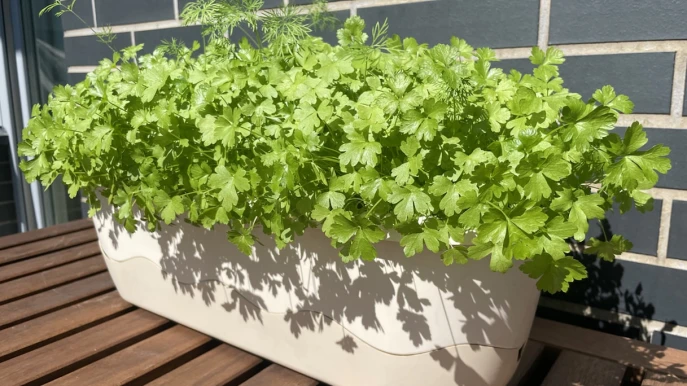Growing Parsley in Pots: Aromatic Delight at Your Fingertips
Creating a small green oasis on your balcony allows you to cultivate the fragrant and versatile parsley in pots, ensuring a fresh supply at your convenience. The vibrant green hues of parsley not only enhance the aesthetics but also elevate the flavors of Mediterranean cuisine. Beyond its culinary prowess, parsley boasts essential oils that stimulate gastric juices, aiding digestion—a valuable ally in various situations. Let’s explore the simple steps to cultivate parsley in pots, bringing this herb within arm’s reach.
Parsley’s Botanical Charm
Plant Characteristics: Parsley (Petroselinum crispum), a biennial member of the Apiaceae family, graces our cuisine with its distinctive taste and numerous benefits. With robust roots, triangular jagged leaves, and delicate white or slightly blue flowers in small umbels, parsley thrives in the Mediterranean. While not overly demanding, it thrives in temperate climates, preferring cool conditions sheltered from direct sunlight.
Ideal Planting Conditions: To safeguard parsley from extreme temperatures, choose a cool, shaded location, especially during the scorching summer months. In regions with short, mild winters, balcony cultivation is feasible. As colder weather approaches, consider bringing the plant indoors or providing insulation with a layer of dry leaves or straw on the balcony.
Planting Parsley: A Step-by-Step Guide
Choosing the Right Pot: For balcony gardening, select a pot with a minimum diameter of 20 cm, offering ample space for parsley’s deep roots. Opt for quality soil for horticultural crops, mixing it with sand. To ensure proper water drainage, place a layer of expanded clay at the pot’s bottom, preventing root rot caused by water stagnation.
Sowing Parsley Seeds: Sow parsley seeds evenly on the soil surface in the pot. Cover them with a thin layer of soil, moisten, and place the pot in sunlight. Ensure temperatures never drop below 14°/15°C during seed germination. Alternatively, expedite the process by germinating seeds indoors using cotton wool or absorbent paper before transferring them to the soil.
Transplanting Parsley: Alternatively, acquire a grown parsley plant and transplant it into your pot. This process, known as planting, is best done when temperatures consistently stay above 15°C. Dig a small hole in the soil, place the plant, and compact the soil around it. Now, the wait begins for your parsley to flourish.
Tricks for Thriving Parsley in Pots
Thinning Out: After parsley reaches 5 cm in height, thin out the plant by pruning smaller branches. This allows better-developed ones to receive more light, air, and nutrients. Remove any dried or diseased branches to prevent issues for the entire plant.
Optimal Watering: While parsley requires regular watering, avoid overdoing it. Water the soil before it completely dries, especially in summer. However, be cautious not to create root-stagnating water puddles. Yellowing leaves indicate excess water and should be promptly addressed.
Pruning for Robust Growth: Periodically prune weaker or diseased twigs during the plant’s growth. This practice strengthens the remaining branches, promoting robust and productive parsley.
Harvesting Parsley: The exciting moment arrives when your parsley is ready for harvest, generally at a height of 15-20 cm. If you need a few leaves, use scissors for precision. Alternatively, cut a tuft of stems, ensuring to leave a few centimeters above the plant’s base to encourage regeneration for the following season.
By following these simple steps and tricks, you can savor the joys of cultivating parsley in pots, bringing the essence of Mediterranean cuisine to your home.



